Edaravone: Difference between revisions
No edit summary |
No edit summary |
||
| Line 212: | Line 212: | ||
|othersTitle=Others | |othersTitle=Others | ||
|useInOthers=(Description) | |useInOthers=(Description) | ||
|administration= | |administration= | ||
=====Preparation and Administration Information===== | |||
*Edaravone is for intravenous infusion only. | |||
=====Preparation===== | |||
*Do not use if the oxygen indicator has turned blue or purple before opening the package. Once the overwrap package is opened, use within 24 hours. | |||
*Parenteral drug products should be inspected visually for particulate matter and discoloration prior to administration, whenever solution and container permit. | |||
=====Administration===== | |||
*Administer each 60 mg dose of edaravone injection as two consecutive 30 mg intravenous infusion bags over a total of 60 minutes (infusion rate approximately 1 mg per minute [3.33 mL per minute]). | |||
*Promptly discontinue the infusion upon the first observation of any signs or symptoms consistent with a hypersensitivity reaction. | |||
*Other medications should not be injected into the infusion bag or mixed with edaravone. | |||
|monitoring= | |||
*Lack of disability progression or maintained functional ability in amyotrophic lateral sclerosis indicates efficacy. | |||
*Hypersensitivity reaction. | |||
|overdose= | |||
|drugBox={{Drugbox2 | |drugBox={{Drugbox2 | ||
| Watchedfields = changed | | Watchedfields = changed | ||
Revision as of 16:13, 13 July 2018
Editor-In-Chief: C. Michael Gibson, M.S., M.D. [1]; Associate Editor(s)-in-Chief: Sonya Gelfand
Disclaimer
WikiDoc MAKES NO GUARANTEE OF VALIDITY. WikiDoc is not a professional health care provider, nor is it a suitable replacement for a licensed healthcare provider. WikiDoc is intended to be an educational tool, not a tool for any form of healthcare delivery. The educational content on WikiDoc drug pages is based upon the FDA package insert, National Library of Medicine content and practice guidelines / consensus statements. WikiDoc does not promote the administration of any medication or device that is not consistent with its labeling. Please read our full disclaimer here.
Black Box Warning
|
Warning Title
See full prescribing information for complete Boxed Warning.
Condition Name: (Content)
|
Overview
Edaravone is a Acetylcholine release inhibitor, Adrenergic receptor agonist that is FDA approved for the (type of indication of drug) of a list of indications, separated by commas.. There is a Black Box Warning for this drug as shown here. Common adverse reactions include a list of adverse reactions, separated by commas..
Adult Indications and Dosage
FDA-Labeled Indications and Dosage (Adult)
Condition 1
- Dosing Information
- (Dosage)
Condition 2
- Dosing Information
- (Dosage)
Off-Label Use and Dosage (Adult)
Guideline-Supported Use
Condition 1
- Developed by: (Organisation)
- Class of Recommendation: (Class) (Link)
- Strength of Evidence: (Category A/B/C) (Link)
- Dosing Information/Recommendation
- (Dosage)
Condition 2
- Developed by: (Organisation)
- Class of Recommendation: (Class) (Link)
- Strength of Evidence: (Category A/B/C) (Link)
- Dosing Information/Recommendation
- (Dosage)
Non–Guideline-Supported Use
Condition 1
- Dosing Information
- (Dosage)
Condition 2
- Dosing Information
- (Dosage)
Condition 3
- Dosing Information
- (Dosage)
Pediatric Indications and Dosage
FDA-Labeled Indications and Dosage (Pediatric)
Condition 1
- Dosing Information
- (Dosage)
Condition 2
- Dosing Information
- (Dosage)
Off-Label Use and Dosage (Pediatric)
Guideline-Supported Use
Condition 1
- Developed by: (Organisation)
- Class of Recommendation: (Class) (Link)
- Strength of Evidence: (Category A/B/C) (Link)
- Dosing Information/Recommendation
- (Dosage)
Condition 2
- Developed by: (Organisation)
- Class of Recommendation: (Class) (Link)
- Strength of Evidence: (Category A/B/C) (Link)
- Dosing Information/Recommendation
- (Dosage)
Non–Guideline-Supported Use
Condition 1
- Dosing Information
- (Dosage)
Condition 2
- Dosing Information
- (Dosage)
Condition 3
- Dosing Information
- (Dosage)
Contraindications
CONTRAINDICATIONS
Warnings
|
Warning Title
See full prescribing information for complete Boxed Warning.
Condition Name: (Content)
|
Conidition 1
(Description)
Conidition 2
(Description)
Conidition 3
(Description)
Adverse Reactions
Clinical Trials Experience
Central Nervous System
- (list/description of adverse reactions)
Cardiovascular
- (list/description of adverse reactions)
Respiratory
- (list/description of adverse reactions)
Gastrointestinal
- (list/description of adverse reactions)
Hypersensitive Reactions
- (list/description of adverse reactions)
Miscellaneous
- (list/description of adverse reactions)
Condition 2
Central Nervous System
- (list/description of adverse reactions)
Cardiovascular
- (list/description of adverse reactions)
Respiratory
- (list/description of adverse reactions)
Gastrointestinal
- (list/description of adverse reactions)
Hypersensitive Reactions
- (list/description of adverse reactions)
Miscellaneous
- (list/description of adverse reactions)
Postmarketing Experience
(Description)
Drug Interactions
- Drug 1
- Drug 2
- Drug 3
- Drug 4
- Drug 5
Drug 1
(Description)
Drug 2
(Description)
Drug 3
(Description)
Drug 4
(Description)
Drug 5
(Description)
Use in Specific Populations
Pregnancy
Pregnancy Category (FDA):
(Description)
Pregnancy Category (AUS):
There is no Australian Drug Evaluation Committee (ADEC) guidance on usage of Edaravone in women who are pregnant.
Labor and Delivery
(Description)
Nursing Mothers
(Description)g
Pediatric Use
(Description)
Geriatic Use
(Description)
Gender
(Description)
Race
(Description)
Renal Impairment
(Description)
Hepatic Impairment
(Description)
Females of Reproductive Potential and Males
(Description)
Immunocompromised Patients
(Description)
Others
(Description)
Administration and Monitoring
Administration
Preparation and Administration Information
- Edaravone is for intravenous infusion only.
Preparation
- Do not use if the oxygen indicator has turned blue or purple before opening the package. Once the overwrap package is opened, use within 24 hours.
- Parenteral drug products should be inspected visually for particulate matter and discoloration prior to administration, whenever solution and container permit.
Administration
- Administer each 60 mg dose of edaravone injection as two consecutive 30 mg intravenous infusion bags over a total of 60 minutes (infusion rate approximately 1 mg per minute [3.33 mL per minute]).
- Promptly discontinue the infusion upon the first observation of any signs or symptoms consistent with a hypersensitivity reaction.
- Other medications should not be injected into the infusion bag or mixed with edaravone.
Monitoring
- Lack of disability progression or maintained functional ability in amyotrophic lateral sclerosis indicates efficacy.
- Hypersensitivity reaction.
IV Compatibility
There is limited information regarding the compatibility of Edaravone and IV administrations.
Overdosage
There is limited information regarding Edaravone overdosage. If you suspect drug poisoning or overdose, please contact the National Poison Help hotline (1-800-222-1222) immediately.
Pharmacology
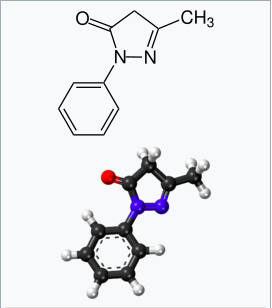
| |
| Template:Px | |
Edaravone
| |
| Systematic (IUPAC) name | |
| 5-methyl-2-phenyl-4H-pyrazol-3-one | |
| Identifiers | |
| CAS number | |
| ATC code | none |
| PubChem | |
| Chemical data | |
| Formula | Template:OrganicBox atomTemplate:OrganicBox atomTemplate:OrganicBoxTemplate:OrganicBoxTemplate:OrganicBoxTemplate:OrganicBoxTemplate:OrganicBoxTemplate:OrganicBoxTemplate:OrganicBoxTemplate:OrganicBoxTemplate:OrganicBoxTemplate:OrganicBoxTemplate:OrganicBoxTemplate:OrganicBox atomTemplate:OrganicBoxTemplate:OrganicBox atomTemplate:OrganicBoxTemplate:OrganicBoxTemplate:OrganicBoxTemplate:OrganicBoxTemplate:OrganicBoxTemplate:OrganicBoxTemplate:OrganicBox |
| Mol. mass | 174.20 g/mol |
| SMILES | & |
| Synonyms | MCI-186 |
| Pharmacokinetic data | |
| Bioavailability | ? |
| Metabolism | ? |
| Half life | ? |
| Excretion | ? |
| Therapeutic considerations | |
| Pregnancy cat. |
? |
| Legal status |
Rx-only (JP) |
| Routes | Intravenous |
Mechanism of Action
- The mechanism by which edaravone exerts its therapeutic effect in patients with ALS is unknown.
Structure
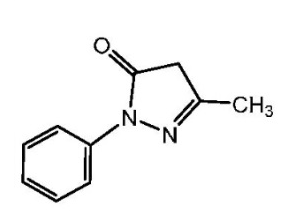
Pharmacodynamics
(Description)
Pharmacokinetics
- Edaravone is administered by IV infusion. The maximum plasma concentration (Cmax) of edaravone was reached by the end of infusion. There was a trend of more than dose-proportional increase in area under the concentration-time curve (AUC) and Cmax of edaravone. With multiple-dose administration, edaravone does not accumulate in plasma.
Distribution
- Edaravone is bound to human serum proteins (92%), mainly to albumin, with no concentration dependence in the range of 0.1 to 50 micromol/L.
Elimination
- The mean terminal elimination half-life of edaravone is 4.5 to 6 hours. The half-lives of its metabolites are 2 to 2.8 hours.
Metabolism
- Edaravone is metabolized to a sulfate conjugate and a glucuronide conjugate, which are not pharmacologically active. The glucuronide conjugation of edaravone involves multiple uridine diphosphate glucuronosyltransferase (UGT) isoforms (UGT1A6, UGT1A9, UGT2B7, and UGT2B17) in the liver and kidney. In human plasma, edaravone is mainly detected as the sulfate conjugate, which is presumed to be formed by sulfotransferases.
Excretion
- In Japanese and Caucasian healthy volunteer studies, edaravone was excreted mainly in the urine as its glucuronide conjugate form (70-90% of the dose). Approximately 5-10% of the dose was recovered in the urine as sulfate conjugate, and only 1% of the dose or less was recovered in the urine as unchanged form. In vitro studies suggest that sulfate conjugate of edaravone is hydrolyzed back to edaravone, which is then converted to the glucuronide conjugate in the human kidney before excretion into the urine.
Specific Populations
Geriatric Patients
- No age effect on edaravone pharmacokinetics has been found.
Patients with Renal and Hepatic Impairment
- No pharmacokinetic data are available in patients with renal impairment or hepatic impairment.
Male and Female Patients
- No gender effect on edaravone pharmacokinetics has been found.
Racial or Ethnic Groups
- There were no significant racial differences in Cmax and AUC of edaravone between Japanese and Caucasian subjects.
Drug Interaction Studies
- The pharmacokinetics of edaravone is not expected to be significantly affected by inhibitors of CYP enzymes, UGTs, or major transporters.
- In vitro studies demonstrated that, at clinical dose, edaravone and its metabolites are not expected to significantly inhibit cytochrome P450 enzymes (CYP1A2, CYP2B6, CYP2C8, CYP2C9, CYP2C19, CYP2D6, CYP3A4), UGT1A1, UGT2B7, or transporters (P-gp, BCRP, OATP1B1, OATP1B3, OAT1, OAT3, and OCT2) in humans. Edaravone and its metabolites are not expected to induce CYP1A2, CYP2B6, or CYP3A4 at the clinical dose level of edaravone.
Nonclinical Toxicology
Carcinogenesis, Mutagenesis, Impairment of Fertility
Carcinogenesis
- The carcinogenic potential of edaravone has not been adequately assessed.
Mutagenesis
- Edaravone was negative in in vitro (bacterial reverse mutation and Chinese hamster lung chromosomal aberration) and in vivo (mouse micronucleus) assays.
Impairment of Fertility
- Intravenous administration of edaravone (0, 3, 20, or 200 mg/kg) prior to and throughout mating in males and females and continuing in females to gestation day 7 had no effect on fertility; however, disruption of the estrus cycle and mating behavior was observed at the highest dose tested. No effects on reproductive function were observed at the lower doses, which are up to 3 times the RHD of 60 mg, on a body surface area (mg/m2) basis.
Clinical Studies
- The efficacy of edaravone for the treatment of ALS was established in a 6-month, randomized, placebo-controlled, double-blind study conducted in Japanese patients with ALS who were living independently and met the following criteria at screening:
- Functionality retained most activities of daily living (defined as scores of 2 points or better on each individual item of the ALS Functional Rating Scale – Revised [ALSFRS-R; described below])
- Normal respiratory function (defined as percent-predicted forced vital capacity values of [%FVC] ≥ 80%)
- Definite or Probable ALS based on El Escorial revised criteria
- Disease duration of 2 years or less
- The study enrolled 69 patients in the edaravone arm and 68 in the placebo arm. Baseline characteristics were similar between these groups, with over 90% of patients in each group being treated with riluzole.
- Edaravone was administered as an intravenous infusion of 60 mg given over a 60 minute period according to the following schedule:
- An initial treatment cycle with daily dosing for 14 days, followed by a 14-day drug-free period (Cycle 1)
- Subsequent treatment cycles with daily dosing for 10 days out of 14-day periods, followed by 14-day drug-free periods (Cycles 2-6).
- The primary efficacy endpoint was a comparison of the change between treatment arms in the ALSFRS-R total scores from baseline to Week 24. The ALSFRS-R scale consists of 12 questions that evaluate the fine motor, gross motor, bulbar, and respiratory function of patients with ALS (speech, salivation, swallowing, handwriting, cutting food, dressing/hygiene, turning in bed, walking, climbing stairs, dyspnea, orthopnea, and respiratory insufficiency). Each item is scored from 0-4, with higher scores representing greater functional ability. The decline in ALSFRS-R scores from baseline was significantly less in the edaravone-treated patients as compared to placebo (see Table 2). The distribution of change in ALSFRS-R scores from baseline to Week 24 by percent of patients is shown in Figure 1.
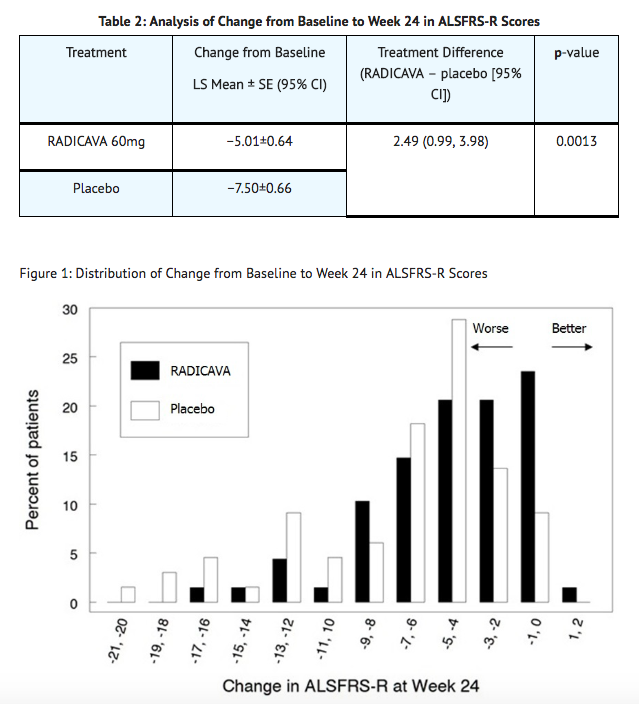
How Supplied
- Edaravone injection is supplied as a 30 mg/100 mL (0.3 mg/mL) clear, colorless, sterile solution for intravenous infusion in single-dose polypropylene bags, each overwrapped with polyvinyl alcohol (PVA) secondary packaging containing an oxygen absorber and oxygen indicator, which should be pink to reflect appropriate oxygen levels. These are supplied in cartons as listed below.
- NDC 70510-2171-1 30 mg/100 mL (0.3 mg/mL) single-dose bag
- NDC 70510-2171-2 2 bags per carton
Storage
- Store at up to 25°C (77°F). Excursions permitted from 15°C to 30°C (59°F to 86°F). Protect from light. Store in overwrapped package to protect from oxygen degradation until time of use. The oxygen indicator will turn blue or purple if the oxygen has exceeded acceptable levels. Once the overwrap package is opened, use within 24 hours.
Images
Drug Images
{{#ask: Page Name::Edaravone |?Pill Name |?Drug Name |?Pill Ingred |?Pill Imprint |?Pill Dosage |?Pill Color |?Pill Shape |?Pill Size (mm) |?Pill Scoring |?NDC |?Drug Author |format=template |template=DrugPageImages |mainlabel=- |sort=Pill Name }}
Package and Label Display Panel
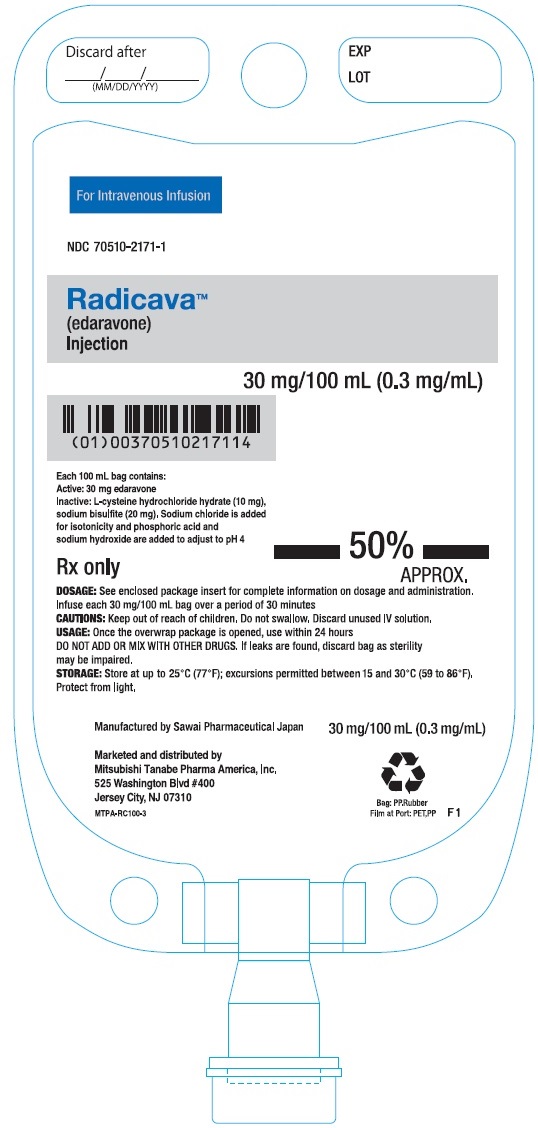
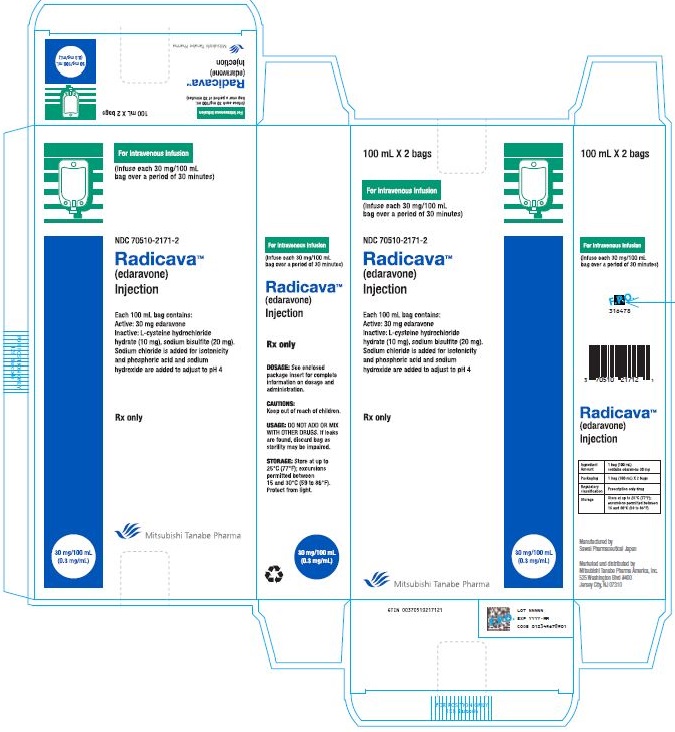
{{#ask: Label Page::Edaravone |?Label Name |format=template |template=DrugLabelImages |mainlabel=- |sort=Label Page }}
Patient Counseling Information
- Advise the patients to read the FDA-approved patient labeling.
Hypersensitivity Reactions
- Advise patients to seek immediate medical care if they experience signs or symptoms of a hypersensitivity reaction.
Sulfite Allergic Reactions
- Advise patients about potential for sulfite sensitivity. Inform patients that edaravone contains sodium bisulfite, which may cause allergic type reactions including anaphylactic symptoms and life-threatening or less severe asthmatic episodes, and to seek immediate medical care if they experience these signs or symptoms.
Pregnancy and Breastfeeding
- Advise patients to notify their healthcare provider if they become pregnant or intend to become pregnant during edaravone therapy.
- Advise patients to notify their healthcare provider if they intend to breastfeed or are breastfeeding an infant.

Precautions with Alcohol
Alcohol-Edaravone interaction has not been established. Talk to your doctor regarding the effects of taking alcohol with this medication.
Brand Names
- Radicava
Look-Alike Drug Names
There is limited information regarding Edaravone Look-Alike Drug Names in the drug label.
Drug Shortage Status
Drug Shortage
Price
References
The contents of this FDA label are provided by the National Library of Medicine.